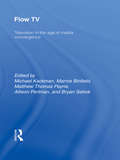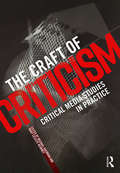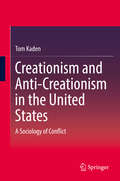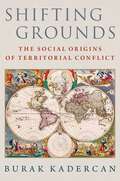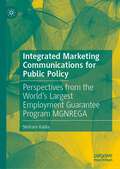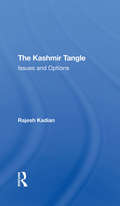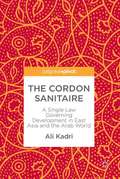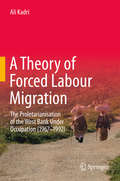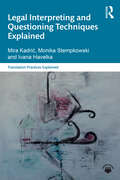- Table View
- List View
Flow TV: Television in the Age of Media Convergence
by Michael Kackman Marnie Binfield Matthew Thomas Payne Allison Perlman Bryan SebokFrom viral videos on YouTube to mobile television on smartphones and beyond, TV has overflowed its boundaries. If Raymond Williams' concept of flow challenges the idea of a discrete television text, then convergence destabilizes the notion of television as a discrete object. Flow TV examines television in an age of technological, economic, and cultural convergence. Seeking to frame a new set of concerns for television studies in the 21st century, this collection of all new essays establishes television’s continued importance in a shifting media culture. Considering television and new media not as solely technical devices, but also as social technologies, the essays in this anthology insist that we turn our attention to the social, political, and cultural practices that surround and inform those devices' use. The contributors examine television through a range of critical approaches from formal and industrial analysis to critical technology studies, reception studies, political economy, and critiques of television's transnational flows. This volume grows out of the critical community formed around the popular online journal Flow: A Critical Form on Television and Media Culture (flowtv.org). It is ideal for courses in television studies or media convergence.
The Craft of Criticism: Critical Media Studies in Practice
by Michael Kackman Mary Celeste KearneyWith contributions from 30 leading media scholars, this collection provides a comprehensive overview of the main methodologies of critical media studies. Chapters address various methods of textual analysis, as well as reception studies, policy, production studies, and contextual, multi-method approaches, like intertextuality and cultural geography. Film and television are at the heart of the collection, which also addresses emergent technologies and new research tools in such areas as software studies, gaming, and digital humanities. Each chapter includes an intellectual history of a particular method or approach, a discussion of why and how it was used to study a particular medium or media, relevant examples of influential work in the area, and an in-depth review of a case study drawn from the author's own research. Together, the chapters in this collection give media critics a complete toolbox of essential critical media studies methodologies.
Russia-China Relations in the Post-Crisis International Order (BASEES/Routledge Series on Russian and East European Studies)
by Marcin KaczmarskiThe book explores developments in Russia-China relations in the aftermath of the global economic crisis, arguing that the crisis transformed their bilateral affairs, regional liaisons and, crucially, altered the roles both states play on the international arena. Discussing how Russo-Chinese cooperation has accelerated in energy trade, arms sales and in the Russian Far East, the focus is on how the still mutually advantageous relationship has become more asymmetric than ever, reflecting China’s meteoric rise and Russia’s decline. These dynamics are explored through three perspectives: domestic, regional and global. Domestically, the book traces the role of political coalitions and key interest groups involved in how the two states shape their reciprocal policies. Changes in the regional dimension are examined with particular reference to a new status quo emerging in Central Asia. The book concludes by explaining how the changing relationship is affecting the international order, including the balance of power vis-à-vis the United States as well as Russia and China’s changing attitudes towards global governance.
Russia-China Relations in the Post-Crisis International Order (BASEES/Routledge Series on Russian and East European Studies)
by Marcin KaczmarskiThe book explores developments in Russia-China relations in the aftermath of the global economic crisis, arguing that the crisis transformed their bilateral affairs, regional liaisons and, crucially, altered the roles both states play on the international arena. Discussing how Russo-Chinese cooperation has accelerated in energy trade, arms sales and in the Russian Far East, the focus is on how the still mutually advantageous relationship has become more asymmetric than ever, reflecting China’s meteoric rise and Russia’s decline. These dynamics are explored through three perspectives: domestic, regional and global. Domestically, the book traces the role of political coalitions and key interest groups involved in how the two states shape their reciprocal policies. Changes in the regional dimension are examined with particular reference to a new status quo emerging in Central Asia. The book concludes by explaining how the changing relationship is affecting the international order, including the balance of power vis-à-vis the United States as well as Russia and China’s changing attitudes towards global governance.
Deccan in Transition, 1600 to 1800: European Dominance and Maratha Sovereignty
by Umesh Ashok KadamThis book presents the socio-cultural and historical trajectories of the Deccan plateau as well as the coastal areas of the current states of Andhra Pradesh, Maharashtra, Karnataka and Goa. It studies the art of diplomacy by discussing the diplomatic relations between the Marathas and various European companies, as well as the indigenous regional states. The author also probes into the Maratha naval policy, the evolution of a composite Deccani culture and the cultural flux that was taking place within the Maratha country. Through an interdisciplinary lens, the volume examines how caste and gender relations operated, how the idea of dissent was generated as well as the socio-political impact of various linguistic, ethnic and religious groups. Through a study of monuments, sculpture and paintings prevalent in the region, the book also discusses the developments in art and architecture in the Deccan. Rich in archival sources, this book is a must read for scholars and researchers of Indian history, colonial history, South Asian history, Maratha history and history in general.
Deccan in Transition, 1600 to 1800: European Dominance and Maratha Sovereignty
by Umesh Ashok KadamThis book presents the socio-cultural and historical trajectories of the Deccan plateau as well as the coastal areas of the current states of Andhra Pradesh, Maharashtra, Karnataka and Goa. It studies the art of diplomacy by discussing the diplomatic relations between the Marathas and various European companies, as well as the indigenous regional states. The author also probes into the Maratha naval policy, the evolution of a composite Deccani culture and the cultural flux that was taking place within the Maratha country. Through an interdisciplinary lens, the volume examines how caste and gender relations operated, how the idea of dissent was generated as well as the socio-political impact of various linguistic, ethnic and religious groups. Through a study of monuments, sculpture and paintings prevalent in the region, the book also discusses the developments in art and architecture in the Deccan. Rich in archival sources, this book is a must read for scholars and researchers of Indian history, colonial history, South Asian history, Maratha history and history in general.
Lebenslanges Lernen Mögliche Bildungswelten: Erwachsenenbildung, Biographie und Alltag (Studien zur Erziehungswissenschaft und Bildungsforschung #10)
by Jochen Kade Wolfgang Seitter2 auf ihr theoretisches und normatives Potential hin abzuklopfen. Uns scheint es sinnvoll, die normative Frage nach den Möglichkeiten anderer, besserer Bildungswelten nicht direkt anzugehen, sondern über einen Umweg, nämlich über die empirische Erforschung der Pluralität gegenwärtiger, historisch möglicher Bildungswelten. Erst deren Rekonstruktion macht den Blick für mögliche Zukünfte offen. Die Vielschichtigkeit der Welt ernst zu nehmen mit der Möglichkeit, aus den gegebenen Elementen immer neue Kombinatio nen und Ordnungen herzustellen, ist auch einer Vorschläge, die Italo Calvino für das nächste Jahrtausend macht: "Wer sind wir denn, wer ist denn jeder von uns, wenn nicht eine Kombination von Erfahrungen, Informationen, Lektü ren und Phantasien? Jedes Leben ist eine Enzyklopädie, eine Bibliothek, ein Inventar von Objekten, eine Musterkollektion von Stilen, worin alles jeder zeit auf jede mögliche Weise neu gemischt und neu geordnet werden kann" (Calvino 1991, S. 165). 3 2 So bestimmen Christian Lüders und Michael Winkler die Sozialpädagogik als einen "Thematisierungsansatz für die individuelle und soziale Interpretation möglicher Bil dungsgeschichten" (Lüders/Winkler 1992, S. 368). 3 V gl. auch die etwas technischere Rede von der "Bastelexistenz" des Menschen von Ronald Hitzier und Anne Honer (1994) aus der Sicht der Individualisierungstheorie. I. Teil: Theoretisches Programm und Forschungspraxis 15 Erstes Kapitel: Lebenslanges Lernen - Theorie-und Forschungsprogramm 1. Lebenslanges Lernen zwischen pädagogischem Diskurs, institutionellem Angebot und individueller Aneignung Seit den 1960er Jahren nimmt der Begriff des lebenslangen Lernens in der erwachsenen bildnerischen Diskussion eine prominente Stellung ein.
Drink and Culture in Nineteenth-century Ireland: The Alcohol Trade and the Politics of the Irish Public House (International Library Of Historical Studies)
by Bradley KadelThe vibrant Irish public house of the nineteenth century hosted broad networks of social power, enabling publicans and patrons to disseminate tremendous influence across Ireland and beyond. During the period, affluent publicans coalesced into one of the most powerful and sophisticated forces in Irish parliamentary politics. Among the leading figures of public life, they commanded an unmatched economic route to middle-class prosperity, inserted themselves into the centre of crucial legislative debates, and took part in fomenting the issues of class, gender, and national identity which continue to be contested today. From the other side of the bar, regular patrons relied on this social institution to construct, manage and spread their various social and political causes. From Daniel O'Connell to the Guinness dynasty, from the Acts of Union to the Great Famine, and from Christmas boxes to Fenianism; Bradley Kadel offers a first and much-needed scholarly examination of the 'incendiary politics of the pub' in nineteenth-century Ireland.
RedakBot
by Ramón KadelDer Journalismus ist im Wandel – nicht nur aufgrund des Medienstrukturwandels durch Digitalisierung und Internet, sondern auch aufgrund neuer Technologien, die erstmals sogar ein Stück weit die Existenzberechtigung des Berufsbilds infrage stellen. Werden Journalisten also durch künstliche Intelligenz ersetzt? Nein! Denn KI im Journalismus ist ein „Frenemy“: Freund und Feind zugleich. Freund, wenn man sich auf den KI-Journalismus vorbereitet, Feind für diejenigen, die ihr Mindset nicht ändern können und die neuen Technologien ausschließlich als Bedrohung sehen. Mit der Lektüre dieses Buches sollen Journalisten und Redakteure sowie Volontäre und Studenten im Bereich der Kommunikationswissenschaften konkrete Ideen im Kopf haben, wie sie sich auf die Zeit des KI-Journalismus erfolgreich vorbereiten. Es regt an, innovativ zu sein, und von den neuen Möglichkeiten, die redaktionelle Bots bieten, zu partizipieren – und schließlich zu profitieren. Die Frage ist nicht, ob „RedakBots“ unsere Arbeitswelt verändern, sondern wann dies passiert. Das Buch bereitet darauf vor.
Creationism and Anti-Creationism in the United States: A Sociology of Conflict
by Tom KadenThis book deals with professional creationist and anti-creationist organizations in America, and describes how the “conflict between science and religion” is the result of the interaction between these two groups. It retraces their history from the 1960s onwards, and identifies crucial turning points that led to new forms of creationism and anti-creationism. It explains their strategies, labels and arguments as effects of this history and structure. Taking a field theoretical approach, the book avoids problems of prior creationism research, making it possible to identify the mechanisms through which creationism generates new strategies, arguments, and media output. The field model is used as an interpretive tool to make sense of some of the most important creationist and anti-creationist publications and media statements.
Shifting Grounds: The Social Origins of Territorial Conflict
by Burak KadercanTerritory has always played a key role in the origins, conduct, and consequences of armed conflict. For territories to exist in any meaningful sense, human groups need to think of them in the first place, and then act upon these thoughts: territory is what states and societies make of it. In Shifting Grounds, Burak Kadercan draws upon a wide variety of cases, ranging from the Thirty Years War to ISIS, to examine the relationship between "territorial ideas" and armed conflict. He argues that states and societies have adhered to different forms of territoriality across time and space, and territory, as well as territorial control, has meant different things in different time periods and regions. Building on this premise, Kadercan makes two claims. First, how state elites conceive territory within and beyond their domains affects their military objectives as well as methods and strategies for waging war. Second, adherence to different forms of territoriality leads to different modes and patterns of war, and wars themselves may affect how state elites and societies conceive territories. Kadercan then turns to the transformative roles that wars can play in shaping dominant territorial ideas and geopolitical assumptions and how the impact of such wars differs in Western and non-Western regions. Ranging broadly across different eras and world regions, Shifting Grounds sheds light on the shifting nature of the relationship between territorial ideas and armed conflict not only in the context of the distant the past, but also in present-day global politics.
Shifting Grounds: The Social Origins of Territorial Conflict
by Burak KadercanTerritory has always played a key role in the origins, conduct, and consequences of armed conflict. For territories to exist in any meaningful sense, human groups need to think of them in the first place, and then act upon these thoughts: territory is what states and societies make of it. In Shifting Grounds, Burak Kadercan draws upon a wide variety of cases, ranging from the Thirty Years War to ISIS, to examine the relationship between "territorial ideas" and armed conflict. He argues that states and societies have adhered to different forms of territoriality across time and space, and territory, as well as territorial control, has meant different things in different time periods and regions. Building on this premise, Kadercan makes two claims. First, how state elites conceive territory within and beyond their domains affects their military objectives as well as methods and strategies for waging war. Second, adherence to different forms of territoriality leads to different modes and patterns of war, and wars themselves may affect how state elites and societies conceive territories. Kadercan then turns to the transformative roles that wars can play in shaping dominant territorial ideas and geopolitical assumptions and how the impact of such wars differs in Western and non-Western regions. Ranging broadly across different eras and world regions, Shifting Grounds sheds light on the shifting nature of the relationship between territorial ideas and armed conflict not only in the context of the distant the past, but also in present-day global politics.
Integrated Marketing Communications for Public Policy: Perspectives from the World’s Largest Employment Guarantee Program MGNREGA
by Shriram KadiaThis book is based on detailed empirical research conducted to analyse the communication dissemination approach applied to the world’s largest employment guarantee program MGNREGA (Mahatma Gandhi National Rural Employment Guarantee Act). To uncover the insights, perspectives and understanding of the program, more than 30 villages in Western parts of India were visited and more than 400 MGNREGA beneficiaries were contacted personally by the author. The book connects the two concepts of Integrated Marketing Communications (IMC) and Public Policy and highlights the importance of using the IMC tools for a meaningful and comprehensible communication dissemination strategies and campaigns. A global overview of public policy dissemination approaches adopted by federal governments in Brazil, Niger, Philippines, Indonesia, Pakistan, Bangladesh, South Africa, and Kenya have been presented to sensitize the readers with the communication dissemination strategies used at the global level. The book presents and discusses a conceptual framework for the ideal public policy communication initiatives and highlights the apt communications vehicles for the illiterate, vulnerable and marginalized beneficiaries.
The Kashmir Tangle: Issues And Options
by Rajesh KadianWith rare objectivity, Rajesh Kadian assesses past and present conflicts in Kashmir, one of the world’s most long-standing trouble spots. He traces the regions controversial history from the 1947 partition to the surging tide of militancy now building in the Kashmir Valley, which has further strained relations between India and Pakistan. Kadians si
The Kashmir Tangle: Issues And Options
by Rajesh KadianWith rare objectivity, Rajesh Kadian assesses past and present conflicts in Kashmir, one of the world’s most long-standing trouble spots. He traces the regions controversial history from the 1947 partition to the surging tide of militancy now building in the Kashmir Valley, which has further strained relations between India and Pakistan. Kadians si
The autonomous life?: Paradoxes of hierarchy and authority in the squatters movement in Amsterdam
by Nazima KadirThis book is an ethnographic study of the internal dynamics of a subcultural squatting community that defines itself as a social movement.
The autonomous life?: Paradoxes of hierarchy and authority in the squatters movement in Amsterdam (PDF)
by Nazima KadirThis book is an ethnographic study of the internal dynamics of a subcultural squatting community that defines itself as a social movement.
The British Army in Palestine and the 1948 War: Containment, Withdrawal and Evacuation (Israeli History, Politics and Society)
by Alon KadishFollowing the end of the Second World War, the main mission of the British Army in Palestine was to contain Jewish attacks and illegal immigration while the fate of the Mandate was being decided. This book is a record of the British Army during the final year of the Mandate and its impact on the course and outcome of the 1948 War.With the decision of the UN General Assembly on 29th November 1947 to partition Palestine and the anticipated eruption of inter-communal violence, the Army was made responsible for the maintenance of law and order throughout Palestine until the termination of the Mandate on 15th May 1948. These crucial months are considered from the point of view of the ranks of the British Army, soldiers and field commanders rather than that of generals and statesmen. It makes extensive use of memoirs, contemporary writing and private diaries, as well as archival material and regimental journals. Subjects such as regimental culture and leisure activities are explored in addition to operations and peace-keeping.The book offers an important contribution to the history of the Middle East, and readers interested in political science, the history of the British Army, military history, Palestine and Israel will find in this book a new and innovative view of the 1948 War.
The British Army in Palestine and the 1948 War: Containment, Withdrawal and Evacuation (Israeli History, Politics and Society)
by Alon KadishFollowing the end of the Second World War, the main mission of the British Army in Palestine was to contain Jewish attacks and illegal immigration while the fate of the Mandate was being decided. This book is a record of the British Army during the final year of the Mandate and its impact on the course and outcome of the 1948 War.With the decision of the UN General Assembly on 29th November 1947 to partition Palestine and the anticipated eruption of inter-communal violence, the Army was made responsible for the maintenance of law and order throughout Palestine until the termination of the Mandate on 15th May 1948. These crucial months are considered from the point of view of the ranks of the British Army, soldiers and field commanders rather than that of generals and statesmen. It makes extensive use of memoirs, contemporary writing and private diaries, as well as archival material and regimental journals. Subjects such as regimental culture and leisure activities are explored in addition to operations and peace-keeping.The book offers an important contribution to the history of the Middle East, and readers interested in political science, the history of the British Army, military history, Palestine and Israel will find in this book a new and innovative view of the 1948 War.
Helping Vulnerable Children and Adolescents to Stay Safe: Creative Ideas and Activities for Building Protective Behaviours (PDF)
by Ginger Kadlec Katie WrenchHelping vulnerable children and young people to build protective behaviours is the key to keeping them safe. Full of creative ideas and activities, this guide provides the tools to help children develop these key skills. Topics include work around: building resilience and problem solving skills; identifying a 'safety network'; developing emotional literacy; awareness of grooming strategies and safe/unsafe touch; and cyber safety. The range of tried and tested techniques will be sure to engage any child in thinking about their personal safety, allowing adult carers to have confidence that their child will be empowered to better identify and avoid harmful situations and behaviours. Practical and easy to use, this is a valuable resource for professionals working with vulnerable children and young people, such as adopted or fostered children and those in residential care, as well as the parents and carers of these children.
Museums Involving Communities: Authentic Connections
by Margaret KadoyamaMuseums Involving Communities: Authentic Connections explores how museums can become more active and also considers how they might involve members of their local communities in their everyday work. Examining the key components of the museum–community relationship, this book looks at both the impact of museums on the cultural and civic lives of local communities and the impact of local communities on the programs, collections, and organizational culture of museums. Advocating an accessible and inclusive approach to museum management, Kadoyama focuses on the role of museum leadership in fostering and deepening community relationships. The result offers insights into how relationships between communities and museums can be forged in practice, how museums can be involved in building healthier communities, and how community engagement strategies can be developed, implemented, and evaluated successfully. Written by an experienced museum professional with extensive experience in community involvement and audience development, Museums Involving Communities is key reading for museum workers looking to make an impact, while building long-term relations with local communities, to the benefit of both museum and community. It should also be of great interest to students taking courses in museum and heritage studies.
Museums Involving Communities: Authentic Connections
by Margaret KadoyamaMuseums Involving Communities: Authentic Connections explores how museums can become more active and also considers how they might involve members of their local communities in their everyday work. Examining the key components of the museum–community relationship, this book looks at both the impact of museums on the cultural and civic lives of local communities and the impact of local communities on the programs, collections, and organizational culture of museums. Advocating an accessible and inclusive approach to museum management, Kadoyama focuses on the role of museum leadership in fostering and deepening community relationships. The result offers insights into how relationships between communities and museums can be forged in practice, how museums can be involved in building healthier communities, and how community engagement strategies can be developed, implemented, and evaluated successfully. Written by an experienced museum professional with extensive experience in community involvement and audience development, Museums Involving Communities is key reading for museum workers looking to make an impact, while building long-term relations with local communities, to the benefit of both museum and community. It should also be of great interest to students taking courses in museum and heritage studies.
The Cordon Sanitaire: A Single Law Governing Development in East Asia and the Arab World (PDF)
by Ali KadriThis work compares the development experiences of East Asia and the Arab world. It posits that in view of the collapse in socialism and its ideological retreat, their development performances are intensely over determined by their modes of integration with world capital. For East Asia, it's through manufacturing of civilian-end use commodities and for the Arab World, through militarism. The book is a unique attempt approaching the topic from the theoretical angle using an analytical comparative perspective.
A Theory of Forced Labour Migration: The Proletarianisation of the West Bank Under Occupation (1967-1992)
by Ali KadriThis book focuses on labour dislocation and migration of Palestinians between 1967 and 1992. In particular, it highlights the social transformations in the occupied Palestinian territory where Palestinian labour was permitted to work in Israel from 1968 onwards. Elaborating on the results of the policy which saw a gradual increase in the number of Palestinian workers commuting daily from a negligible proportion of the actively participating labour force, to 35 percent of all employed persons, and 60 percent of all wage paid workers, the book studies this unique case which embodies characteristics from permanent migration situations not only in the de-jure, but also the de-facto sense; insofar as it embeds higher risks and reallocates resources as if it was a permanent relocation scenario. Illustrated with tables and econometric results, the book identifies the determinants and implications of migrant labour from the West Bank using two broad methodologies: the neoclassical and the historical-structural method. Each of these methods is divided into two branches: the classical divided into price determined and a choice-theoretic framework,and the historical-structural divided into dependency and Marxist theory. In order to gain a comprehensive understanding of the situation, all four perspectives are employed in the investigation. In doing so, what emerges is a structure for the book which takes shape along the different lines of migration literature. The book provides new insights into the making of wage labour and labour migration theory.
Legal Interpreting and Questioning Techniques Explained (Translation Practices Explained)
by Mira Kadrić Monika Stempkowski Ivana HavelkaLanguage and law are closely linked, and language is fundamental to the application of the law. Legal, criminalistic, translational and psychological aspects of communication come together in interpreted questioning (hearings, interrogations, interviews) and must be taken into account, especially since the way in which the questioning outcomes are evaluated can have far-reaching legal consequences. Building on empirical studies and practice, this accessible text provides a transdisciplinary examination of questioning methods and strategies. The institutional framework conditions of a questioning situation are examined in the context of transdisciplinary cooperation.This book also addresses the increasing use of technology and hybrid forms of translation and interpreting in the legal system, and shows different ways in which interpreters co-construct information. Chapters include summaries of key concepts and definitions, examples from existing literature combined with practical experience and the results of surveys conducted by the authors, as well as further reading and non-language-specific study activities. Activities include role plays on thematic scenarios involving different actors in criminal proceedings and discussion groups to enable reflection on ethical issues and discursive challenges.This is a vital text for both advanced students and professionals in interpreting studies and criminology.
